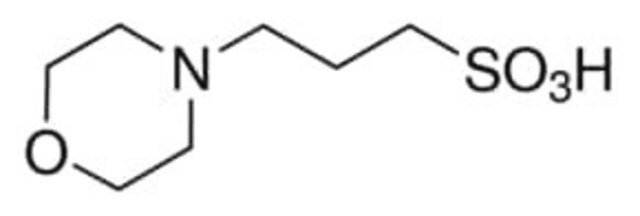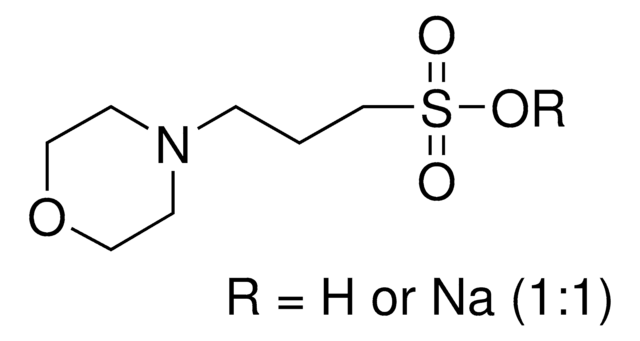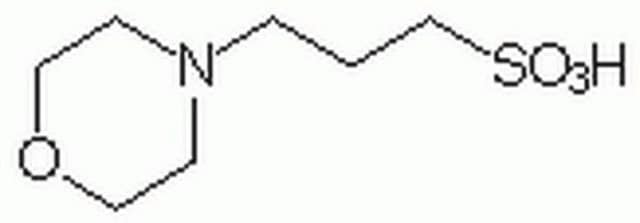M3183
MOPS
≥99.5% (titration), crystalline powder, BioPerformance Certified, suitable for cell culture
Synonyme(s) :
Acide 3-(N-morpholino)propanesulfonique, Acide 4-morpholinopropanesulfonique
About This Item
Produits recommandés
product name
MOPS, BioPerformance Certified, suitable for cell culture, ≥99.5% (titration)
Qualité
BioPerformance Certified
Niveau de qualité
Pureté
≥99.5% (titration)
Forme
crystalline powder
Technique(s)
cell culture | mammalian: suitable
Impuretés
endotoxin and TAMC, tested
pH
2.5-4 (25 °C, 209 g/L)
Plage de pH utile
6.5-7.9
pKa (25 °C)
7.2
Traces de cations
Fe: ≤5 ppm
λ
33 % in H2O
Application(s)
diagnostic assay manufacturing
Activité étrangère
DNase, RNase, protease, none detected
Chaîne SMILES
OS(=O)(=O)CCCN1CCOCC1
InChI
1S/C7H15NO4S/c9-13(10,11)7-1-2-8-3-5-12-6-4-8/h1-7H2,(H,9,10,11)
Clé InChI
DVLFYONBTKHTER-UHFFFAOYSA-N
Vous recherchez des produits similaires ? Visite Guide de comparaison des produits
Application
- A production platform for disulfide-bonded peptides in the periplasm of Escherichia coli.: This research developed a novel platform for producing disulfide-bonded peptides in E. coli, using MOPS buffer to maintain a stable pH environment essential for protein folding and stability in the periplasmic space. The platform could significantly enhance the production of therapeutically relevant peptides (Gibisch et al., 2024).
Conditionnement
Chaque kit contient 3 échantillons de 100 g, chaque échantillon étant issu d'un lot de fabrication différent.
Autres remarques
Code de la classe de stockage
11 - Combustible Solids
Classe de danger pour l'eau (WGK)
WGK 1
Point d'éclair (°F)
230.0 °F - closed cup
Point d'éclair (°C)
110 °C - closed cup
Équipement de protection individuelle
dust mask type N95 (US), Eyeshields, Gloves
Certificats d'analyse (COA)
Recherchez un Certificats d'analyse (COA) en saisissant le numéro de lot du produit. Les numéros de lot figurent sur l'étiquette du produit après les mots "Lot" ou "Batch".
Déjà en possession de ce produit ?
Retrouvez la documentation relative aux produits que vous avez récemment achetés dans la Bibliothèque de documents.
Les clients ont également consulté
Notre équipe de scientifiques dispose d'une expérience dans tous les secteurs de la recherche, notamment en sciences de la vie, science des matériaux, synthèse chimique, chromatographie, analyse et dans de nombreux autres domaines..
Contacter notre Service technique








